The Antiques & Antiquities of London
By Mike McLeod
Last November, my wife and I flew to London to celebrate our 25th wedding
anniversary ten months late. After failing to do something memorable for our
20th wedding anniversary, I was determined to succeed with the 25th even if it
was almost a year late.
London is fabulous. From antiques to antiquities, you
can find also everything there.
The Markets. London has an abundance of
open-air markets on weekends and during the week. New, old, vintage, pop,
ancient it's all there. Portabello Road in the Notting Hill area (yes, the
location of the Hugh Grant and Julia Roberts movie) is probably the best known
for its great variety of antiques, general merchandise, food and fruit. The road
is closed off on Saturdays, and many vendors set up along the street. Because it
is so well known, it is packed with people by 10 am.
The second-hand market
starts at the top of the street, and walking downhill, you pass stands selling
fruit and vegetables, baked goods, various other goods and household items, from
detergent and batteries to cashmere and jewelry. We stopped here to buy and
enjoy a great spinach-stuffed pastry and a crème-filled scone with chocolate
icing.
About halfway down Portabello Road, there are lots of antique shops
and "arcades." No video games here, arcades are like mini antique malls with
dozens of dealers' booths crowded in narrow aisles that wind around through the
building and sometimes connect with other arcades. We ducked into the Geoffrey
Van Arcade and admired spectacular Wedgwood jasperware from the 17th century,
cross stitched samplers from the 15th to 18th centuries, Edwardian silver,
Orientalia, prints, antique tools, snuff shoes (which are snuff boxes crafted in
the shape of shoes) just about everything. Allow for plenty of time when you
go, there is so much to see here.
For collectors and souvenir hunters, the
Apple and Jubilee Markets were the best. Located in Covent Garden, these two
markets are situated beside each other. Both had some antiques, as well as new
items, but Jubilee was more of a flea market. There, my wife Marla bought five
16-inch strings of freshwater pearls for $20, after a little negotiating. (They
were a hit as presents.) We also picked up a commemorative coronation spoon from
1937 for $2, a china thimble for the same price, a miniature teacup, and an
English tobacco tin of large pennies (pence) for about $6; this large pence is
the right size for some trade stimulators.
The Apple Market had a little
higher quality antiques and new items, including a nice selection of 18th and
19th century pots and pot lids (fish paste, yummy!). Around the corner was a
pasties shop where we stopped for a snack. Not pasty glue, but a bread pastry
filled with bacon, potatoes and cheese (as I had), lamb and mint (Marla's), or a
number of other hearty ingredients.
Walking back to the Underground station,
we passed some street performers with blue painted faces and clothes and making
strange noises as they entertained the crowd. For my money, some of the best
things in London, like the markets and the people, are free.
The Free
Antiquities
The British Library. After our overnight flight to London, we arrived at our
hotel early in the morning before check in time. Because of the nine-hour
flight, our tour planner (Marla) had left our first day open to recuperate from
traveling. But with no bed until the afternoon, we headed out to visit the
British Library. Originally, we didn't have it on our list of sites to see, but
it turned out to be a highlight of the trip.
Admittance to the British
Library is free, but a donation is requested. In the John Ritblat Gallery is an
ongoing exhibit titled, "Treasures of the British Library." In it, you can see
the following for free:
- Two of the four known existing copies of the Magna
Carta. One copy was very dark having survived a fire. An accompanying video
explained that there is no evidence that the original document was actually
written down when the barons forced King John in 1215 to enter into an agreement
with them about their rights not the common people's rights. The barons were
tired of being thrown in jail by the king without a trial and being heavily
fined and taxed to support his reign. After agreeing to their terms, King John
went home to the castle and violated all his promises, so the barons called him
on the carpet again in a year or so and had him affix his seal to the Magna
Carta. (The video pointed out that there is no evidence that King John knew how
to write, hence the seal.) Several copies were made of the document and
distributed to bishops and sheriffs just in case King John tried to renege
again.
With no security guards around and nothing but a sheet of glass
(probably, bullet-proof, though) between me and both copies, I was able to get
within six inches of possibly the most important document in English history.
Also on display were:
- A Gutenberg Bible dated to 1454-1455 and one of the
first 180 copies that was printed.
- Jane Austen's handwritten book
Persuasion displayed on her personal lap writing desk.
- Beowulf, an 11th
century copy recorded on vellum.
- Charles Dickens' printed copy of David
Copperfield, which was an unbound stack of pages with a blue paper cover.
- Rudyard Kipling's handwritten copy of "The Tale of the Mongoose" from The Jungle
Book.
- Handel's Messiah, dated 1742.
- Beethoven's Ninth Symphony.
- For Beatles fans, the original handwritten lyrics for: Yesterday, I Wanna Hold
Your Hand, Ticket to Ride, Fool on the Hill, and Help!
- Three sketches by
Leonardo da Vinci from 1504-1506 depicting a mechanical pipe organ, rollers and
the movement of a river.
- Queen Elizabeth's mid-1500s letter to Parliament
wherein she refuses to name a successor, but did promise to consider
marriage.
- The logbook of the HMS Victory from October 21, 1805 detailing
Lord Nelson's victory over the French fleet at Trafalgar and recording his death
in the battle.
- Captain James Cook's journal dated from February 21,
1775.
- Stamps from the British Stamp Act that inflamed American colonists,
which led to the rallying cry of "No taxation without representation" and helped
inspire the Revolution.
- Mr. William Shakespeare's Comedies, Histories and
Tragedies, the first collected folio edition from 1623; Richard III; and
Shakespeare's mortgage from 1613.
- A handwritten letter from Sir Isaac
Newton to Robert Hooke in 1679. Hooke accused Newton of plagiarism and said that
centrifugal force was "an illusion." The letter detailed Newton's response.
- A 24-page book on astronomy by Galileo Galilei printed in 1610 with his drawing
of the Pleiades Constellation. Galileo was eventually forced by the Inquisition
to recant his findings which supported Copernicus' heretical belief at the time
that the earth circles the sun.
Whew. I was overwhelmed with the sheer
magnitude of the collection. What I've described above is just some of the
highlights and maybe one percent of the antiques and antiquities on display.
National Gallery. In its permanent collection, the National Gallery has
paintings dating from about 1250 A.D. More than 50 rooms have paintings on
display enough space to hold more than 2,000 double-decker buses. Among the
highlights that enthralled us were: Sun Flowers, by Van Gogh; Rembrandt's Self
Portrait; Ruben's Samson and Delilah; Raphael's The Madonna of the Pinks
("pinks" refers to the carnations in the painting); Leonardo da Vinci's The
Virgin of the Rocks; Botticelli's Venus and Mars; Van Eyck's The Arnolfini
Portrait, or as some have loosely titled it, "The Shotgun Wedding"; and The
Entombment by Michelangelo. We were also treated to masterpieces by Renoir,
Dega, Cezanne, Van Dyck, Monet, Turner, Canaletto, Bellini, and many more, of
course. All free.
National Portrait Gallery. Located on Trafalgar Square near
the National Gallery, it was established in 1856 and has paintings of 350 famous
people, including: Anne Boleyn; Jane Austen (ca. 1810); King Charles I (1631);
Captain James Cook (1776); Oliver Cromwell (ca. 1649); Charles Darwin (1881);
Elizabeth I; King George III (1761-1762); George Frideric Handel (1756); and
many others.
The British Museum. Seeing this was on par or even better than
the British Library. The British Museum houses one of the greatest collections
of antiquities in the world, including Egyptian, Roman, Greek, Assyrian,
Etruscan, Mayan, and other civilizations.
In the entrance to the Egyptian
rooms, the very first showcase holds the Rosetta Stone, the key to translating
hieroglyphics. In this first long hall were also: a giant stone head of Ramses,
Pharaoh of Egypt, who had a throw down with Moses; sarcophagi, statues, tablets
and figures. Amazingly, many of these items were out in the open, and you could
touch them. They were on display with no barriers or cases around them. Of
course, precious items like the Rosetta Stone were under glass. I couldn't
resist touching a sarcophagus, a seated pharaoh statue carved from black stone,
and a Roman mosaic in a stairwell. (There were so many antiquities in the
British Library that stairwells and hallways were used for display.)
In the
Roman area, the most dramatic exhibit is the Elgin Marbles. Displayed in a
50-yard-long room, the Marbles were taken from the Parthenon in 1806 by Thomas
Bruce, the 7th Earl of Elgin and ambassador to the Ottoman Empire. (The Turks
were at war with the Greeks at the time, and they were occupying Athens and
using the Parthenon to store weapons and gunpowder.) Fearing for the safety of
the Marbles, Lord Elgin secured permission from the Turks to take some of them
and some sculptures to protect them, he said.
The Marbles depict an annual
ceremony in which a procession of people and horsemen take a new robe to the
goddess Athena. The Marbles adorned a set of columns inside the Parthenon while
another set or carvings in high relief called metopes adorned the outside above
the columns. Of the original 92, about 15 metopes are in the museum, and they
tell the story of a battle between centaurs and a people known as the Plinths.
After the king of the Plinths invites the centaurs to a wedding ceremony, they
get drunk and start to carry off the Plinthian women. The men fight the
centaurs, and in the end, the men and the women lose.
The great
controversy surrounding the Marbles is that Greece wants them back, naturally.
This has been a great battle, much like that of the Plinths and the centaurs.
But no matter who wins this one, the Elgin Marbles are magnificent.
Other
highlights of the museum include: the Portland Vase (a blown glass vase with a
carved white overlay depicting Romans that was created at about the time of
Christ); giant Assyrian winged bulls with human heads that were cut in half for
transport to England; Assyrian frieze carvings depicting a royal lion hunt (an
entire room was devoted to them because there were so many panels; they recorded
the hunt in frame-by-frame fashion, like a comic strip); splendid black and
burnt orange Greek vases; Etruscan vases; mosaics from Rome and Greece; dozens
of tablets with hieroglyphics; and much more.
Cleopatra's Needle. Actually,
Cleopatra had nothing to do with this obelisk because she wasn't born at the
time it was carved. But that's what everyone calls it. Ramses the Great (about
the time of Moses) carved part of it. It was found by British explorers who
encased it in an iron tube and shipped it toward England. The ship sank, but the
obelisk was later recovered and erected on the banks of the Thames. Probably a
hundred feet high, this Egyptian treasure stands by a street. It is open to the
weather and to passersby to enjoy free of charge.
Admission Only Antiquities
Tower of London. Her Majesty's Royal Palace and Fortress, the Tower of London
is a complex of about 20 towers, one of which protects the Crown Jewels.
Fortunately, we followed a travel book's advice and saw the Crown Jewels before
we took the Beefeater's tour of Tower Green (where Henry VIII had two of his
wives, Anne Boleyn and Katherine Harris, beheaded), the White Tower (which was
built by William the Conqueror in 1078 for defense), the Bloody Tower (where
executions took place), St. George's Chapel, and other buildings. After the
tour, the line to see the crown jewels was out the door.
To see the Crown
Jewels, you walk through several rooms, including one showing a video of the
Queen's coronation, and a few more that house a Queen's ransom in place settings
and other paraphernalia for royal occasions virtually all gold. Some of those
included:
- 10 golden maces, including the maces of George I (1689) and
William and Mary (1689).
- State trumpets, 1780-1848.
- St. Edward's
Staff, 1661.
- Golden coronation spoon, 1661.
- St. Edward's crown,
1661.
- Sovereign's orb, 1661.
- Queen Mary II's golden orb of state
(1600) and her crown.
- Altar dishes, 1664.
- Golden flagons.
- A
golden wine cistern, or grand punchbowl, the size of a washtub, 1829.
- Several salts: St. George's salt cellar, c. 1661, in the shape of a castle,
about 12-18 inches high.
- A christening ewer and basin, c. 1735.
The
actual Crown Jewels are displayed in several cases in the center of the room
with a moving sidewalk in front of them to keep the line moving. Although I
had seen them before in person and had a book of pictures of them, they were
still a wonder to behold. Unfortunately, no photography was
allowed.
Westminster Abbey. Founded in 960 as a Benedictine monastery,
William the Conqueror was crowned here in 1066. About the size of a football
stadium, Westminster Abbey is famous for the people buried there. Carved tombs
are everywhere, in alcoves and sandwiched in along the hallways. Some of the
notables included:
- Queen Elizabeth I, daughter of King Henry VIII by Anne
Boleyn, 1533-1603.
- Her half-sister Mary I, who burned heretics at the
stake, and died in 1603. Oddly, both are buried in same tomb.
- Mary, Queen
of Scots, who was beheaded by Queen Elizabeth.
- And the tombs of King Henry
III, Edward I, Edward II, Richard II, and Henry V.
Other famous people are
entombed under the floor tiles. In the well known Poets' Corner, there is: Lord
Byron, George Eliot (Mary Ann Evans), Alfred Lord Tennyson, George Frederick
Handel, Jane Austen, Samuel Johnson, Laurence Olivier, Charlotte Bronte, Keats,
Shelly, Burns, William Wordsworth, Lewis Carroll, Chaucer, Charles Dickens and
Rudyard Kipling.
Certainly the oldest and most unique piece of furniture in
Westminster Abbey is the Coronation Chair, which has been used for every
coronation since 1296.
There is, of course, much more to see in
London, but alas, I have run out of space to write about it. If you'd like to
read more about the antiques and the antiquities of London and find some travel
tips, visit our website, www.go-star.com/antiquing.
|
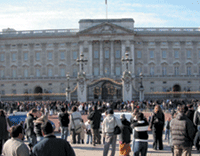
Buckingham Palace with
the crowd gathering for the Changing of the Guard.
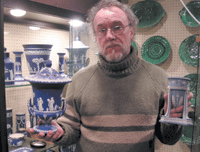
Mike Witts holding his favorite Wedgwood jasperware from the 1600s and 1700s.
He also sells jelly moulds in his "arcade" booth.
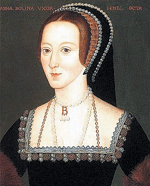
Portrait of Anne Boleyn (ca. 1504-1536), second wife of Henry VIII. (Photo: ©
National Portrait Gallery, London.)
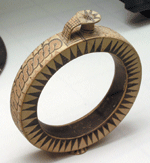
A ceramic Greek perfume
bottle
of remarkable shape in
the British
Museum.
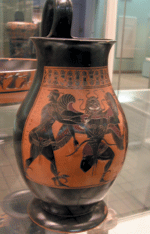
Greek vase depicting Perseus
fighting Medousa. His head is turned so he
won't turn to stone.
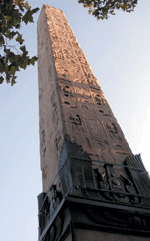
Cleopatra's Needle rests
on the banks of the Thames for
all to freely
admire.
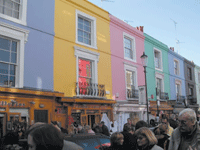
Colorful antique shops along London's famous Portabella
Road on a crowded
Saturday.
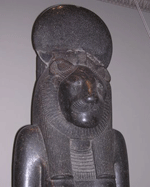
Many Egyptian figures were
displayed unprotected and
touchable!
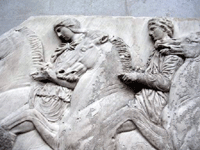
One of the Elgin Marbles showing three horsemen abreast.
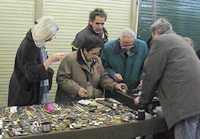
Collectors at the Jubilee Market look for trinkets and treasures.
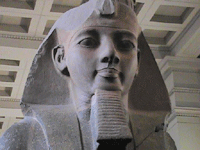
A huge partial statue of
Ramses II.
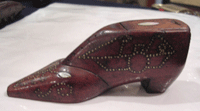
A snuff shoe that opens from
the top to dispense snuff. |